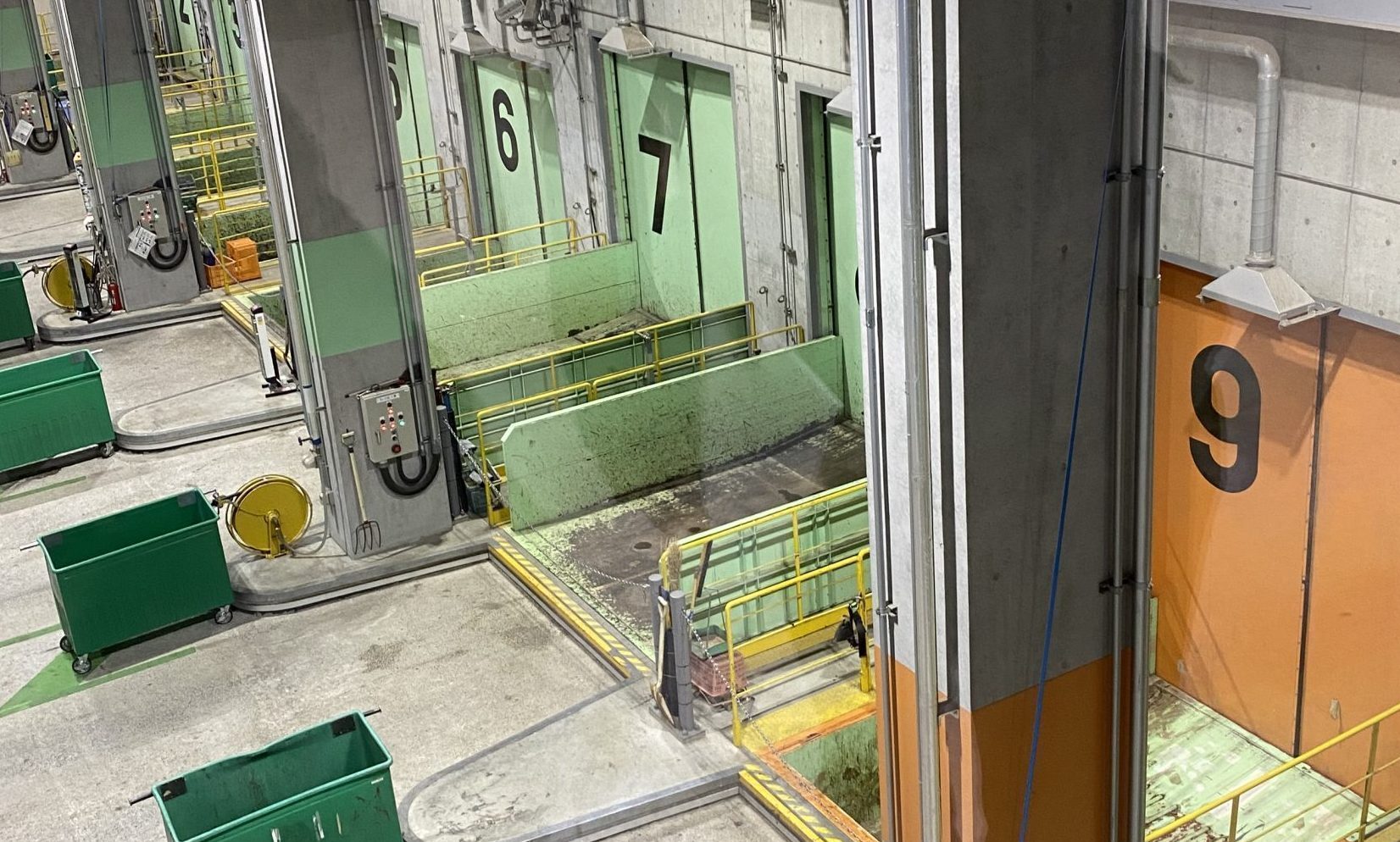Kyoto, 18 March 2023: On the sideline of the 9th 3R International Scientific Conference on Material Cycles and Waste Management (3RINCs) 2023, the Regional Knowledge Centre of Marine Plastic Debris (RKC-MPD) team visited Kyoto South Clean Centre Plant No. 2 in Fushimi Ward, to learn one of the ways the city is managing its waste. There are several facilities in the plant, including waste sorting, waste incineration, biogasification, and Sustaina Kyoto, an environmental education facility.
‘The whole plant was funded by government of Kyoto, except for the biogasification facility, which was partly funded by the national government’, said Mr Kazuki Hirota, the guide of the tour from Kyoto University.
Waste Sorting Facility
Waste sorting is a fundamental step for the entire process since this is where everything begins. To feed the incinerator, waste comes into the plant through different doors (see above image). Large size waste comes through green doors, while pliable waste, such as futons, tatami mats, and carpets comes through orange ones. The sizable waste would then be shredded by high-speed rotary shredder. In this process, iron, aluminium, and copper particles would be separated with the help of the sorters. Meanwhile, the pliable waste would be cut by hydraulically operated blades before being fed to the incinerator.
Waste Incineration Facility
Waste to energy works by turning waste into electricity by producing heat through incineration. The mechanism operates in a way that firstly, shredded waste from the waste sorting facility would feed into the furnaces of the incinerator with the minimum temperature of 9000C.

Figure 2. Shredded waste being fed into the incinerator.
The generated heat will boil water to produce high-pressure steam that moves turbines, which in turn generates electricity up to 14.000 kW. A part of this electricity is used to run the plant facilities, but the rest of the electricity is sold to the power company. Overall, the electricity generated from this plant could power 22.000 households/year.

Figure 3. The officer from the Kyoto South Clean Center Plant No. 2 showing the illustration of the heat inside the furnace.
Figure 3. The officer from the Kyoto South Clean Center Plant No. 2 showing the illustration of the heat inside the furnace
To control air pollution, the incineration facility is supported by several equipment, such as bag filters to remove fine dust and dioxins from the exhaust gas, activated carbon adsorption tower to adsorb and remove harmful substances, wet gas scrubber to remove the sulphur oxides, hydrogen chloride, and other substances, and denitration reaction tower to blow ammonia into the exhaust gas to decompose nitrogen oxides and nitrogen.
To manage ash, the incineration is equipped with dust treatment facility and ash crane. The dust generated during the waste to energy process is first collected by the bag filter in the dust treatment facility and stabilized with chemicals. After that, the collected dust will be loaded into ash trucks with the ash crane.
Biogasification Facility
Similarly, biogasification also has its objective to turn waste into energy. However, what makes it different is that the facility uses organic materials, such as food waste to produce biogas that can generate electricity.
Firstly, the organic materials would be extracted from general waste using a pre-treatment equipment. This equipment consists of a shredder and a bag breaker to break down the waste into suitable size for fermentation, as well as sorting tools to remove the non-suitable waste. After that, the organic waste would be sent to the methane fermentation tank. At this stage, the microorganism introduced will decompose the waste into biogas, mainly methane. The generated methane will then be stored in the gas holder for temporary storage before being used to power the generator and produce electricity. Annually, the generator can produce up to 1.000 kW that can power 2.000 households.

Figure 4. The fermentation tank of biogasification facility.
Sustaina Kyoto (environmental education facility)
Sustaina Kyoto is a publicly open space where visitors can learn about the waste to energy process. In this facility, visitors can take a tour to observe the supporting facilities of waste to energy, such as incinerator, fermentation tank, and control room.

Figure 5. The control room
During the tour, the visitors were introduced to “Do you Kyoto?”, a campaign catchphrase that encourages people to take positive actions for the environment. The campaign itself aims to promote environmentally friendly lifestyle, such as substituting plastic bags to reusable bags/tote bags, segregating waste at household level, preventing littering, etc.
On the ground floor of the facility, panels with information related to Kyoto Environmental Report were on display. This included solid waste data, such as 399 gram/day/person, and food loss in Kyoto reaching 5,7 thousand tons/year for the city, along with the target of the city to reduce its greenhouse gas emission by 40% in 2030.
‘The waste generation in Kyoto tends to peak in December because it is holiday time and people usually clean their houses’, closed Mr Hirota.

Figure 6. The wall panels at the Sustaina Kyoto Environmental Education (Source: Sustaina Kyoto, 2023)

